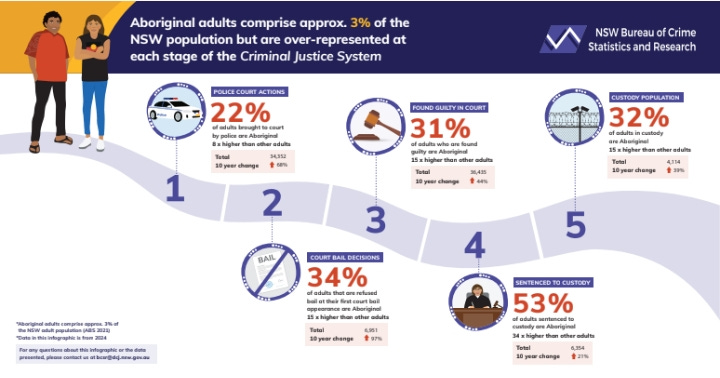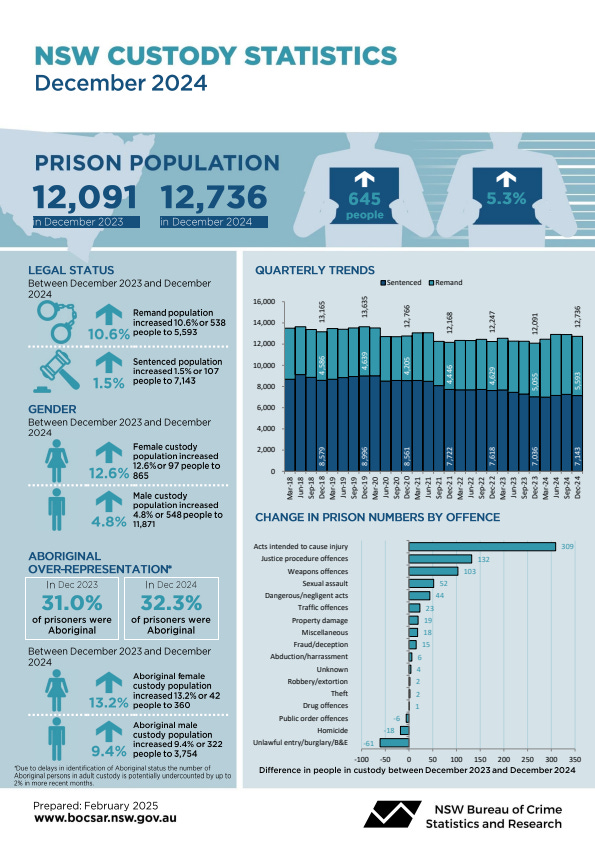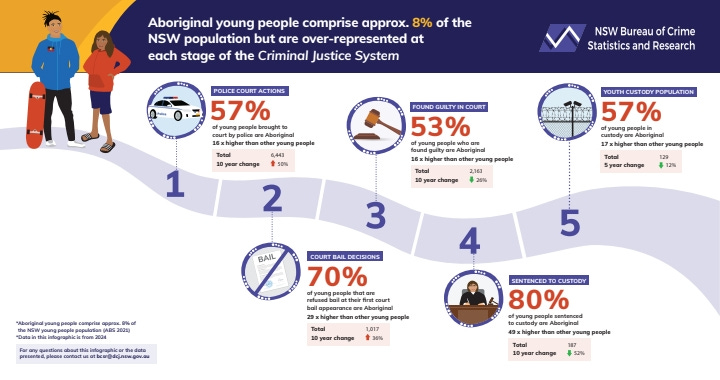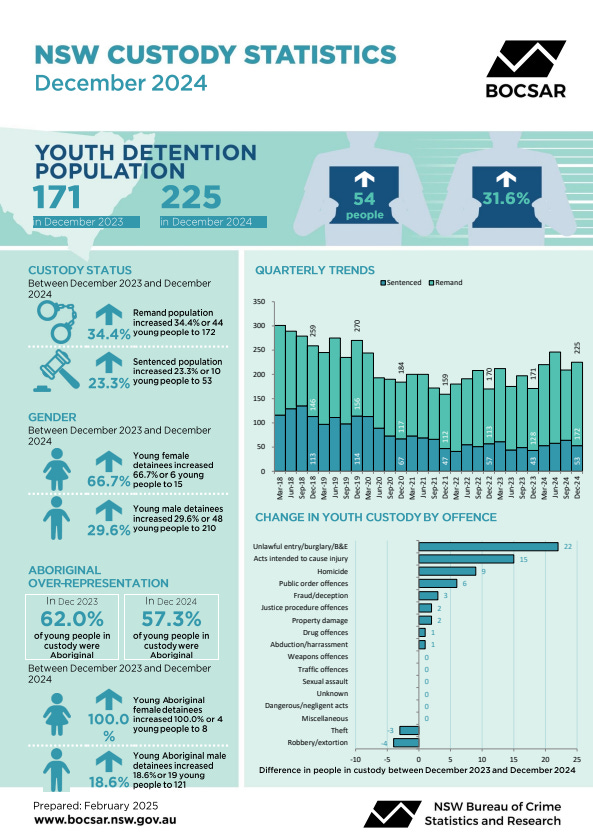Fifteen Years of Legal Action: NSW Police Priorities and the Communities Left Behind
An evidence-based review of policing, charging, bail, and custody trends across New South Wales from 2009 to 2024.
CONTENT WARNING:
This article discusses themes of racial disparity, custodial injustice, sexual violence, and the overrepresentation of Aboriginal people in New South Wales' criminal justice system. Reader discretion is advised.
INTRODUCTION
In NEW SOUTH WALES, the GAP BETWEEN GOVERNMENT PROMISES AND COMMUNITY OUTCOMES HAS REMAINED STUBBORNLY WIDE.
For well over a (DECADE,) Aboriginal people have been chronically overrepresented at every stage of the state’s CRIMINAL JUSTICE PROCESS — from POLICE ENCOUNTERS to BAIL HEARINGS, SENTENCING, AND INCARCERATION.
Despite “POLITICAL RHETORIC” about EQUITY and REFORM, especially under frameworks like “CLOSING THE GAP,” official statistics show that the SITUATION HAS NOT IMPROVED.
IN SOME AREAS, SUCH AS YOUTH CUSTODY AND BREACH-OF-BAIL CHARGES, THE DISPARITY HAS ACTUALLY WORSENED.
This expanded report brings together 15 years of legal action data, court trends, and official infographics from the NSW Bureau of Crime Statistics and Research (BOCSAR), to illustrate how enforcement and punishment continue to fall unequally across racial and age lines. The outcomes remain consistent, year after year — and the consequences are profound.
Legal Action Trends: 2009–2023
According to the BOCSAR BB175 Report (2025):
Robbery: 21% → 40% (+19.9 p.p.)
Break & Enter (non-dwelling) 6.1% → 18.9% (+12.8 p.p.)
Motor Vehicle Theft: 4.7% → 12.6%
DV-Related Assault: 60% → 66.5%
Sexual Assault: declined from 10.2% → 6.9% (–3.4 p.p.)
The LEGAL ACTION rate for Sexual Assault Fell — Despite An Increase In REPORTED INCIDENTS, particularly from SURVIVORS of historical CHILD ABUSE. Meanwhile, PROPERTY CRIMES saw SUBSTANTIAL ENFORCEMENT GROWTH.
This DISCREPANCY raises hard questions:
Why are police INCREASINGLY PURSUING LOW-LEVEL PROPERTY OFFENCES while FALLING BEHIND ON SEXUAL VIOLENCE?
And what does this say about INSTITUTIONAL PRIORITIES?
ABORIGINAL ADULTS IN THE SYSTEM
The 2024 Aboriginal Adult Infographic illustrates sustained overrepresentation:
32% of adults in custody are Aboriginal, despite making up only a small fraction of the NSW population.
Aboriginal adults are 34 times more likely to be sentenced to imprisonment.
31% of all guilty verdicts in NSW courts involve Aboriginal defendants.
53% of adults brought before the courts are Aboriginal.
34% of those refused bail at their first appearance are Aboriginal — 15 times the rate of non-Aboriginal adults.
These figures are not ISOLATED SPIKES. They have remained consistent across years, and across changes in government and policy frameworks. They reflect long-standing structural inequality in the administration of justice.
ABORIGINAL YOUNG PEOPLE IN CUSTODY
The 2024 Aboriginal Youth Infographic offers an even more sobering snapshot:
70% of young people refused bail at first court appearance are Aboriginal — 29 times the rate of other youth.
57% of youth in custody are Aboriginal — 17 times more likely than their peers.
53% of youth found guilty are Aboriginal.
Aboriginal youth are 49 times more likely to receive a custodial sentence than non-Aboriginal youth.
These figures have emerged despite MULTIPLE LEGAL SAFEGUARDS, including the YOUNG OFFENDERS ACT 1997, which was designed to prioritise diversion and Rehabilitation. In practice, it remains UNDERUSED and INCONSISTENTLY APPLIED — particularly to ABORIGINAL CHILDREN.
BREACH AND PROCEDURAL CHARGES
The Closing the Gap September 2024 Report provides further detail:
In 2023, 4,662 Children aged 10–13 were proceeded against.
41.3% of these were Aboriginal children.
22.9% of all charges for children under 14 were for procedural matters — mainly breach of bail.
Breach of BAIL is not a Violent Offence. In many cases, it Involves Technical Failures: Missing A Check-in, Being Late To A Court Appearance, or Being Out Of Home After Curfew — often linked to Family Breakdown, Poverty, or Housing Instability.
THESE ARE NOT THREATS TO PUBLIC SAFETY. YET THEY REMAIN ONE OF THE MOST COMMON REASONS ABORIGINAL CHILDREN ARE PULLED INTO CUSTODY.
THE DECEMBER 2024 CUSTODY STATISTICS CONFIRM:
A continued rise in remand populations
A growing proportion of Aboriginal people in both adult and youth custody
That girls and women — particularly Aboriginal — are being remanded in record numbers
CONCLUSION: A SUSTAINED IMBALANCE
Fifteen years of quantitative data — combined with frontline EXPERIENCE AND LIVED TESTIMONY — CONFIRM A PATTERN of legal disparity in NEW SOUTH WALES.
Aboriginal people, especially children and women, continue to be disproportionately targeted for surveillance, enforcement, and incarceration. Meanwhile, the response to crimes such as sexual violence lags behind, raising questions about how institutional resources are prioritised.
Accountability in the Justice System should not depend on RACE, POSTCODE, or PAPERWORK COMPLIANCE. It should reflect FAIRNESS, EQUITY, and EVIDENCE-BASED INTERVENTION. Until that becomes more than a POLITICAL SLOGAN, the outcomes will CONTINUE TO FALL where they ALWAYS HAVE — HARDEST ON THOSE LEAST EQUIPPED TO BEAR THEM.
DISCLAIMER
This report contains public data, survivor-informed testimony, and official statistics derived from NSW Bureau of Crime Statistics and Research (BOCSAR), NSW Government “Closing the Gap” reports, and publicly released court documents.











